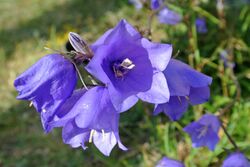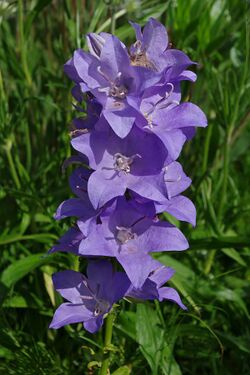Biology:Campanula
| Bellflower | |
|---|---|

| |
| Campanula persicifolia near Tehumardi, Saaremaa, Estonia. | |
| Scientific classification | |
| Kingdom: | Plantae |
| Clade: | Tracheophytes |
| Clade: | Angiosperms |
| Clade: | Eudicots |
| Clade: | Asterids |
| Order: | Asterales |
| Family: | Campanulaceae |
| Subfamily: | Campanuloideae |
| Genus: | Campanula L.[1] |
| Type species | |
| Campanula latifolia | |
| Synonyms[3] | |
|
List
| |
Campanula (/kæmˈpænjʊlə/)[4] is the type genus of the Campanulaceae family of flowering plants. Campanula are commonly known as bellflowers and take both their common and scientific names from the bell-shaped flowers—campanula is Latin for "little bell".
The genus includes over 500 species and several subspecies, distributed across the temperate and subtropical regions of the Northern Hemisphere, with centers of diversity in the Mediterranean region, Balkans, Caucasus and mountains of western Asia.[5] The range also extends into mountains in tropical regions of Asia and Africa.[3]

The species include annual, biennial and perennial plants, and vary in habit from dwarf arctic and alpine species under 5 cm high, to large temperate grassland and woodland species growing to 2 metres (6 ft 7 in) tall.
Description
upright=1.35|thumbThe leaves are alternate and often vary in shape on a single plant, with larger, broader leaves at the base of the stem and smaller, narrower leaves higher up; the leaf margin may be either entire or serrated (sometimes both on the same plant). Many species contain white latex in the leaves and stems.[6]
The flowers are produced in panicles (sometimes solitary), and have a five-lobed corolla, typically large (2–5 cm or more long), mostly blue to purple, sometimes white or pink. Below the corolla, 5 leaf-like sepals form the calyx. Some species have a small additional leaf-like growth termed an "appendage" between each sepal, and the presence or absence, relative size, and attitude of the appendage is often used to distinguish between closely related species.[6]
The fruit is a capsule containing numerous small seeds.[6]
Campanula species are used as food plants by the larvae of some Lepidoptera species including common pug (recorded on harebell), dot moth, ingrailed clay (recorded on harebell), lime-speck pug and mouse moth.[7][citation needed]
Cultivation and uses
Well-known species include the northern temperate Campanula rotundifolia, commonly known as harebell in England and bluebell in Scotland and Ireland (though it is not closely related to the true bluebells), and the southern European Campanula medium, commonly known as Canterbury bells (a popular garden plant in the United Kingdom). As well as several species occurring naturally in the wild in northern Europe, there are many cultivated garden species.
The cultivars 'Misty Dawn'[8] and 'Kent Belle'[9] have gained the Royal Horticultural Society's Award of Garden Merit.
The species Campanula rapunculus, commonly known as rampion bellflower, rampion, or rover bellflower, is a biennial vegetable which was once widely grown in Europe for its spinach-like leaves and radish-like roots.[10] In many English translations of the Brothers Grimm's tale Rapunzel, rampion is the vegetable that is stolen from the witch. (Rapunzel is a completely different plant, Valerianella locusta.)
In the UK the National Collection of campanulas is held at Burton Agnes Hall in East Yorkshire[11] and the National Collection of Alpine Campanulas at Langham Hall, Bury St Edmunds, in Suffolk.[12]
Related genera
The classification of some Campanulaceae genera as either part of Campanula or separate genera can vary by system, including Azorina, Campanulastrum, Canarina, Edraianthus, Musschia, Ostrowskia, and Platycodon. Some genera previously not segregated from Campanula currently are segregated in some systems, including Annaea, Gadellia, and Theodorovia. Hemisphaera was formerly Campanula, subsect. Scapiflorae, and Neocodon was Campanula sect. Rapunculus.[13]
Species


There are 473, including:
- Campanula aghrica – Aghrian bellflower
- Campanula alliariifolia – Cornish bellflower
- Campanula alaskana
- Campanula alpestris
- Campanula alpina
- Campanula americana – American bellflower
- Campanula balfourii – Socotra bellflower
- Campanula barbata – bearded bellflower
- Campanula betulifolia
- Campanula bononiensis
- Campanula bravensis
- Campanula carpatica – Carpathian bellflower
- Campanula cervicaria – bristly bellflower
- Campanula cochleariifolia – fairies' thimbles
- Campanula collina – blue dwarf bellflower
- Campanula divaricata – Appalachian bellflower
- Campanula garganica – Adriatic bellflower
- Campanula gelida
- Campanula glomerata – clustered bellflower
- Campanula hercegovina
- Campanula isophylla – Italian bellflower
- Campanula jacobaea
- Campanula lactiflora – milky bellflower
- Campanula lanata
- Campanula lasiocarpa
- Campanula latifolia – wide-leaved bellflower
- Campanula latiloba – great bellflower
- Campanula medium – Canterbury bells
- Campanula napuligera
- Campanula parryi
- Campanula patula – spreading bellflower
- Campanula pendula
- Campanula persicifolia – peach-leaved bellflower
- Campanula piperi – Piper's bellflower
- Campanula portenschlagiana – Dalmatian or wall bellflower
- Campanula poscharskyana – Serbian bellflower
- Campanula primulifolia – Spanish bellflower
- Campanula punctata
- Campanula pyramidalis – chimney bellflower
- Campanula raineri – Rainer's bellflower
- Campanula rapunculoides – creeping bellflower
- Campanula rapunculus – rampion bellflower
- Campanula robinsiae
- Campanula rotundifolia – harebell, bluebell
- Campanula scabrella – rough bellflower
- Campanula scheuchzeri
- Campanula scouleri – Scouler's or pale bellflower
- Campanula shetleri – Castle Crags bellflower
- Campanula spicata
- Campanula takesimana – Korean bellflower
- Campanula thyrsoides
- Campanula trachelium – nettle-leaved bellflower
- Campanula uniflora – Arctic bellflower
- Campanula wilkinsiana – Wilkin's bellflower
- Campanula zoysii
Formerly placed here
- Adenophora gmelinii (Spreng.) Fisch. (as C. coronopifolia Schult. or C. gmelinii Spreng.)
- Adenophora khasiana (Hook.f. & Thomson) Collett & Hemsl. (as C. khasiana Hook.f. & Thomson)
- Adenophora liliifolia (L.) Besser (as C. liliifolia L.)
- Adenophora triphylla (Thunb.) A.DC. (as C. tetraphylla Thunb. or C. triphylla Thunb.)
- Azorina vidalii (H.C.Watson) Feer (as C. vidalii H.C.Watson)
- Borago pygmaea (DC.) Chater & Greuter (as C. pygmaea DC.)
- Eastwoodiella californica (Kellogg) Morin (as C. californica (Kellogg) A.Heller)
- Legousia pentagonia (L.) Druce (as C. pentagonia L.)
- Legousia speculum-veneris (L.) Durande ex Vill. (as C. speculum-veneris L.)
- Platycodon grandiflorus (Jacq.) A.DC. (as C. glauca Thunb. or C. grandiflora Jacq.)
- Ravenella angustiflora (Eastw.) Morin (as C. angustiflora Eastw.)
- Ravenella exigua (Rattan) Morin (as C. exigua Rattan)
- Ravenella griffinii (Morin) Morin (as C. griffinii Morin)
- Ravenella sharsmithiae (Morin) Morin (as C. sharsmithiae Morin)
- Triodanis perfoliata (L.) Nieuwl. (as C. perfoliata L.)
- Wahlenbergia linarioides (Lam.) A.DC. (as C. linarioides Lam.)
- Wahlenbergia marginata (Thunb.) A.DC. C. gracilis G.Forst. or C. marginata Thunb.)
- Wahlenbergia undulata (L.f.) A.DC. (as C. undulata L.f.)[14]
Chemistry
Violdelphin is an anthocyanin, a type of plant pigment, found in the blue flowers in the genus Campanula.[15]
Fossil record
Three fossil seeds of †Campanula palaeopyramidalis have been extracted from borehole samples of the Middle Miocene fresh water deposits in Nowy Sacz Basin, West Carpathians, Poland .[16]
References
- ↑ "Genus: Campanula L.". Germplasm Resources Information Network. United States Department of Agriculture. 2004-01-29. http://www.ars-grin.gov/cgi-bin/npgs/html/genus.pl?1989.
- ↑ lectorype designated by Britton & Brown, Illustrated Flora of the Northern United States (ed. 2) 3: 294 (1913)
- ↑ 3.0 3.1 "World Checklist of Selected Plant Families: Royal Botanic Gardens, Kew". http://apps.kew.org/wcsp/namedetail.do?name_id=363841.
- ↑ Sunset Western Garden Book, 1995:606–607
- ↑ Altervista Flora Italiana, Genere: Campanula - Famiglia: Campanulaceae
- ↑ 6.0 6.1 6.2 Flora of China, v 19 p 530, 风铃草属 feng ling cao shu, Campanula Linnaeus, Sp. Pl. 1: 163. 1753.
- ↑ "Campanula". http://campanulaceae.myspecies.info/taxonomy/term/13516/descriptions.
- ↑ "RHS Plant Selector - Campanula 'Misty Dawn'". https://www.rhs.org.uk/Plants/327491/i-Campanula-i-Misty-Dawn/Details.
- ↑ "RHS Plant Selector - Campanula 'Kent Belle'". https://www.rhs.org.uk/Plants/85551/Campanula-Kent-Belle/Details.
- ↑
 Rines, George Edwin, ed (1920). "Rampion". Encyclopedia Americana.
Rines, George Edwin, ed (1920). "Rampion". Encyclopedia Americana.
- ↑ "Burton Agnes Hall – Campanula Collection". https://www.burtonagnes.com/The_Gardens/Walled_Garden/Campanula_Collection.html.
- ↑ "Home". http://www.bellflowernursery.co.uk/.
- ↑ Tatyana V. Shulkina, John F. Gaskin and W. M. M. Eddie, "Morphological Studies toward an Improved Classification of Campanulaceae s. str.," Annals of the Missouri Botanical Garden 90.4 (2003), pp. 578, 583.
- ↑ "GRIN Species Records of Campanula". Germplasm Resources Information Network. United States Department of Agriculture. http://www.ars-grin.gov/cgi-bin/npgs/html/splist.pl?1989.
- ↑ Structure and biosynthesis of anthocyanins in flowers of Campanula. Kirsten Brandt, Tadao Kondo, Hideki Aoki and Toshio Goto, Phytochemistry, 29 April 1993, Volume 33, Issue 1, Pages 209–212, doi:10.1016/0031-9422(93)85424-P
- ↑ Łańcucka-Środoniowa M.: Macroscopic plant remains from the freshwater Miocene of the Nowy Sącz Basin (West Carpathians, Poland) [Szczątki makroskopowe roślin z miocenu słodkowodnego Kotliny Sądeckiej (Karpaty Zachodnie, Polska)]. Acta Palaeobotanica 1979 20 (1): 3–117.
- Fitter, R; A Fitter (1974). The Wild Flowers of Britain and Northern Europe. Collins.
External links
Wikidata ☰ Q157069 entry
 |

